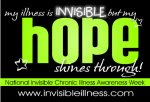Our Illnesses May Be Invisible, but They're Very Real

Thank you www.headaches.about.com for the information.
From Teri Robert,
Your Guide to Headaches / Migraine.
Our Illnesses May Be Invisible, But They're Very Real
September 11-17 is National Invisible Chronic Illness Awareness Week. We have some great resources and opportunities to learn more yourself and to educate others...
National Invisible Chronic Illness Awareness Week
We who live with chronic headaches and Migraine disease have something in common with 96% of people who live with a chronic illness -- our illness is invisible. We don't live with our heads bandaged, walk with a cane, or show any other outward sign of our illness.
This can create a problem in terms of public awareness, the support we receive from those around us, and in how we're perceived by others. "Out of sight, out of mind" applies here. People can't see signs of our illnesses, so they often think we're perfectly healthy. We can look great even when we're debilitated. Looking great, however, doesn't diminish the huge impact of such conditions.
Chronic Illness Facts
**Nearly 1 in 2 Americans (133 million) has a chronic condition.
**That number is projected to increase by more than one percent per year by 2030, resulting in an estimated chronically ill population of 171 million.
**96% of them live with an illness that is invisible.
**These people do no use a cane or any assistive device and may look perfectly healthy.
**90% of seniors have at least one chronic disease and 77% have two or more chronic diseases.
**The divorce rate among the chronically ill is over 75%.
**Studies have reported that physical illness or uncontrollable physical pain are major factors in up to 70% of suicides.
Building Awareness
September 11-17, 2006, is National Invisible Chronic Illness Awareness Week (NICIAW). The theme this year is, "My Illness Is Invisible But My Hope Shines Through!" NICIAW is an annual major public awareness campaign sponsored by HopeKeepers Magazine, a consumer magazine that offers spiritual encouragement for those who live with chronic illness or pain.
Paul J. Donoghue and Mary Siegel, co-sponsors of the week and authors of "Sick and Tired of Feeling Sick and Tired: Living With Invisible Chronic Illness" say,
"Invisible chronic illnesses (ICI) have symptoms that are difficult to see and impossible to measure such as pain and fatigue. So those with ICI frequently encounter not compassion and support but impatience and skepticism from physicians and loved ones."
Lisa Copen, the editor of HopeKeepers Magazine who lives with rheumatoid arthritis and fibromyalgia, commented,
"Living with an illness that is invisible to those around us can often have a more devastating affect on our emotional health than the physical pain... Each day we must choose to have hope, despite how medications and alternative treatments may help or hinder us... Just because someone isn’t using a wheelchair doesn’t mean that she doesn’t have a disability. Friends and family of those with chronic illness care a great deal about what their loved ones are going through, but oftentimes the invisibility of the illness sets up an environment for misunderstandings and even doubt about the validity of the illness. We hope to increase awareness of how many people ‘look great’ but are hurting deeply."
Online conference
During NICIAW, an online conference of more than 20 online seminars is being held. The seminars are being conducted via an online chat room. The seminars are being conducted by chronic illness coaches, authors, patient advocates, nutritionists, and other professionals. On Thursday, September 14, I'll be conducting a seminar "Empowerment over the pain," at 6p.m., eastern time. For more information on the conference and a complete schedule of seminars, visit www.invisibleillness.org.
Summary
For many of us, the invisibility of our illness and the resulting lack of understanding and compassion from others is as difficult to handle as the illness itself. During National Invisible Chronic Illness Awareness Week, let's make an extra effort to learn more ourselves as well as help educate others.
_____________
Resources:
Press Release: "96% of Illness is Invisible – Many Look Good but Feel Terrible." HopeKeepers. September, 2006.
"Chronic Conditions: Making the Case for Ongoing Care." Chronic Care in America: A 21st Century Challenge, a study of the Robert Wood Johnson Foundation & Partnership for Solutions: Johns Hopkins University, Baltimore, MD for the Robert Wood Johnson Foundation (September 2004 Update).
United States Census Bureau. 2002.
Anderson, Gerard, Ph.D. "The Growing Burden of Chronic Disease in American." Public Health Reports. Volume 110, May-June, 2004.
Mackenzie TB, Popkin MK. "Suicide in the medical patient." International Journal of Psychiatry in Medicine 17:3-22, 1987

<< Home